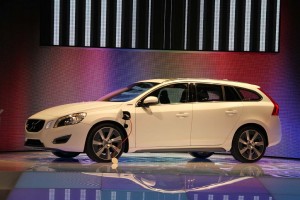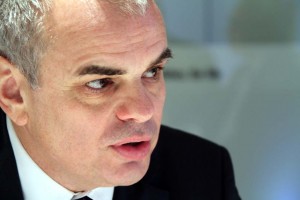Long identified with the latest in safety technology, Sweden’s Volvo is putting an increasing emphasis on battery power. By the end of the decade, in fact, the majority of its products will be driven by hybrid-electric, plug-in or pure battery-electric powertrains, Volvo Chief Executive Stephan Jacoby reveals.
Until now lagging behind many of its competitors when it comes to the “electrification” of the automobile, Volvo is rapidly making up for lost time. It is preparing to launch its first battery-electric vehicle, or BEV, a version of the compact C30. And Volvo is using its stand at this month’s Geneva Motor Show to give the public a look at the plug-in diesel-hybrid version of its bigger V60 wagon, which it plans to bring to market in 2012.
“I would say the majority (if Volvo products) would use some form of electrification” by 2020, Jacoby, a former Volkswagen executive, revealed. “I think the CO2 regulations will lead to that.”
Jacoby joined the Swedish maker last year after Volvo was acquired by the ambitious Chinese Geely Holding Co. Last month, the parent firm revealed plans to invest as much as $11 billion into its new subsidiary, part of a global growth strategy that it expects to double Volvo sales.
Much of that growth is expected to come in the booming Chinese market. To make that work, Volvo has confirmed it will set up an assembly plant in Chengdu, next to an existing Geely factory. The maker is also “investigating” the need for a second Chinese plant, though that appears to be a fait accompli, Jacoby quickly reveals. (For more on Volvo’s expansion plans, Click Here.)
The push into China relieves some of the pressure to try to build demand in Volvo’s existing markets, notably including the U.S., where it had lost ground in recent years. But Jacoby believes there are opportunities to tap in the States, as well, proclaiming, “We’re good for 100,000 (sales) in 2015,” compared to just 56,000 last year.
Volvo is looking at “ideas and alternatives to reduce our exposure to the (weak) U.S. dollar,” which forces the maker to either raise prices or reduce profit margins, Jacoby suggested, though he declined to say whether that would involve a long-anticipated American assembly plant. Exporting from China does not appear to be under consideration – at least for now.
Chinese regulators have been pressing the auto industry to shift from internal combustion to electric power – reflecting the nation’s dual problems with smog and a lack of domestic oil supplies. So it’s understandable that Volvo’s new masters would be leading the push to electrify.
According to Jacoby, Volvo’s strategy has “three pillars”:
- Battery-electric vehicles, like the C30 – which will reach the U.S. late this year;
- Plug-ins; and
- Conventional hybrids, which Volvo sees a “a way to offer high-power engines with stunning fuel-efficiency,” according to Jacoby.
Ironically, while competitors like Toyota and Ford started out with simple hybrids and are migrating to more advanced battery systems, the Swedish maker is starting out with a BEV and will only get a conventional hybrid to market in 2015, according to Jacoby.
Volvo’s increasing focus on battery power might satisfy environmentalists – and may work in China, where regulators can exert a strong influence over what is still a command economy. But whether the technology will connect with consumers in the West is less certain, as Jacoby acknowledged.
In Europe, battery power’s higher costs will be offset by the savings on fuel. And the run-up in gas prices in the U.S. could add momentum, as well, though Jacoby stressed his belief that American legislators “need to tax fuel.”
It would be the most effective way to get consumers to “make intelligent choices,” the Volvo CEO asserted, “and not go back to old habits.”


